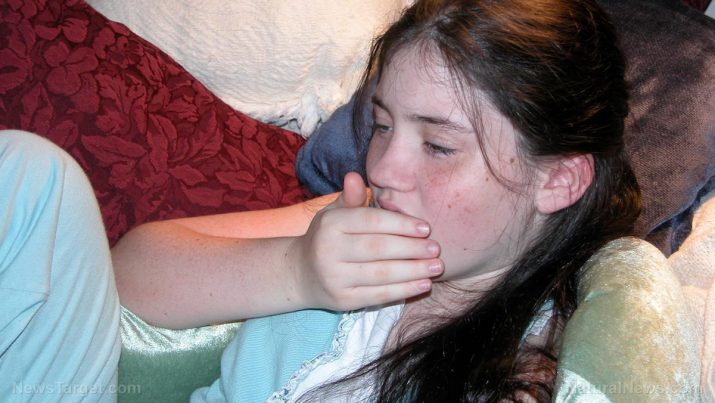
Neuroblastoma – causes, side effects and treatments at NaturalPedia.com
Thursday, May 24, 2018 by Zoey Sky
http://www.naturalpedia.com/neuroblastoma-causes-side-effects-and-treatments-at-naturalpedia-com.html

Neuroblastoma is a disease wherein cancerous (or malignant) cells form in the nerve tissue of the adrenal gland, chest, neck, or spinal cord. Neuroblastoma usually starts in the nerve tissue of the adrenal glands.
The disease can also start in the chest, in the nerve tissue near the spine in the neck, or in the spinal cord.
Patients often develop neuroblastoma during early childhood, such as in children younger than five years old. Sometimes the disease forms before birth but it is usually diagnosed later, like when the tumor starts to grow and cause side effects.
While neuroblastoma is rarely diagnosed before birth, it is possible through a fetal ultrasound. In most cases, neuroblastoma is diagnosed but the cancer has usually spread (metastasized) to either the bones, bone marrow, liver, lymph nodes, and skin.

Known side effects of neuroblastoma
Most of the side effects of neuroblastoma are due to pressure from the tumor or bone pain if cancer has spread to the bones. Pain may cause a child to limp or become unable to walk.
The other side effects of neuroblastoma usually include:
- Changes in the eyes like black eyes, changes in the color of the iris, a constricted pupil, a droopy eyelid, or vision problems.
- Constant diarrhea or high blood pressure, often caused by hormones released by the tumor.
- Difficulty breathing, pain in the chest, or a persistent cough.
- Eyes that bulge out and dark circles under the eyes, especially when cancer has spread behind the eyes.
- Fever and anemia (a low level of red blood cells).
- A lump or mass in the abdomen, chest, neck, or pelvis.
- Pain in the arms, legs, or other bones.
- Pain in the back, or weakness, numbness, or paralysis of the legs, especially if the tumor has spread to the spinal cord.
- Rotating movements of the eyes and sudden muscle jerks which could be caused by immune system problems due to the disease
- Skin lesions or nodules under the skin with blue or purple patches.
In some cases, children with neuroblastoma will not experience these side effects. Sometimes, the cause of a side effect is another medical condition.
Risk factors for neuroblastoma may include:
- Age — Neuroblastoma is common in very young children. The disease rarely develops in individuals older than 10.
- Having birth defects/congenital anomalies — Young patients with birth defects may have an increased risk of developing neuroblastoma.
- Heredity — In at least one to two percent of cases of the disease, children inherit an increased risk of developing neuroblastoma from a parent.
Body systems harmed by neuroblastoma
The complications of neuroblastoma will depend on the body parts affected by the disease. While modern treatments are very effective and can save a patient’s life, they can also result in long-term complications such as:
- Hearing problems
- An increased risk of developing another cancer
- Infertility in later life
Food items or nutrients that may prevent neuroblastoma
The following foods or nutrients can help prevent neuroblastoma and strengthen the brain and nervous system:
- Avocados — Avocados are full of vitamin K and folate which can prevent blood clots in the brain.
- Broccoli — Broccoli is full of vitamin K that can boost brain power and cognitive skills.
- Dark chocolate — Dark chocolate is rich in flavonols that have anti-inflammatory and anti-oxidant properties.
- Fish — The nerves are protected by myelin sheaths, which are rich in fatty acids. Fish has omega-3 fatty acids that can help heal the nerves and nervous system.
- Green leafy vegetables — Green leafy vegetables are full of magnesium and vitamin B complex, vitamin C, and vitamin E that are crucial for the proper functioning of the nervous system.
- Pumpkin seeds — Pumpkin seeds are a great source of copper, iron, magnesium, and zinc.
Treatments, management plans for neuroblastoma
The treatment for neuroblastoma depends on the stage and the risk group. Very young children with low-risk neuroblastoma don’t usually require any treatment because this type of neuroblastoma may resolve on its own.
Treatment for other children with neuroblastoma may include:
- Chemotherapy
- Radiotherapy
- Surgery
Treatment for the disease depends on the risk group. For example, children with low-risk neuroblastoma only need surgery, with or without chemotherapy. Young patients with intermediate-risk or high-risk neuroblastoma may require a combination of chemotherapy, radiotherapy, and surgery.
Where to learn more
- CBD oil helps autistic boy speak again
- Curcumin infused nanoparticles found to target and destroy neuroblastoma cancer tumors… has the CURE been found?
- Frankincense oil kills cancer cells while boosting the immune system, studies show
- Glycyrrhizic acid modulates t-BHP induced apoptosis in primary rat hepatocytes[PDF]
- Low-cost medicine created from Indian spices, herbs effectively fights aggressive forms of cancer, say researchers
Summary
Neuroblastoma is a disease wherein cancerous (or malignant) cells form in the nerve tissue of the adrenal gland, chest, neck, or spinal cord.
Most of the side effects of neuroblastoma are due to pressure from the tumor or bone pain if the cancer has spread to the bones. Pain may cause a child to limp or become unable to walk.
Risk factors for neuroblastoma may include age, having birth defects/congenital anomalies, and heredity.
Neuroblastoma can cause long-term complications such as hearing problems, an increased risk of developing another cancer, and infertility in later life.
Avocados, broccoli, dark chocolate, fish, green leafy vegetables, and pumpkin seeds can help prevent neuroblastoma and strengthen the brain and nervous system.
The treatment for neuroblastoma depends on the stage and the risk group. Very young children with low-risk neuroblastoma don’t usually require any treatment because this type of neuroblastoma may resolve on its own.
Treatment for other children with neuroblastoma may include chemotherapy, radiotherapy, and surgery.
Sources include:
Tagged Under: Tags: neuroblastoma





